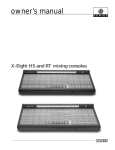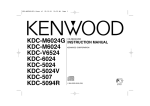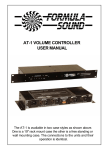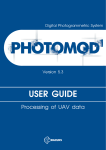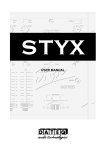Download Peavey X-Four User's Manual
Transcript
owners manual X-Four mixing console Ø X-Four Block Diagram 2 R L 1 L R MONITOR OUT SOURCE SELECT POST / PRE FADER SOLO AUDIO ON OFF SOLO OFF SCL+ SCL- FROM SOLO LOGIC L R 4 HP LEVEL NO R L +10 1 3 Σ Σ Σ Σ Σ Σ Σ Σ Σ 3 LO MID 4 PEAK +10 +10 block diagram X-Four owner’s manual table of contents mono inputs stereo inputs p. 7 p. 25 group p. 41 master p. 57 power supply p. 81 1 2 3 4 5 X-Four owner’s manual how to use this manual conventions terms indicators or controls employed on the X-Four console will appear as: TERMS tasks are broken down into steps 1 2 3 warnings Procedures not to attempt. Issues or hazards to keep in mind when operating the equipment. a indicators What to look for on-screen. Alerts, indicators, or prompts that may appear. ® tips Prefered methods. Helpful hints. Feature insights. + see see—references other sections of the manual containing supplementary information on the current topic or a related issue 1 mono input module module block diagram X-Four owner’s manual panel legend p. 6 mono input module 1 features phantom power—+48V 48 volts DC is applied to pins 2 and 3 on the mic-input XLR connector. This option is used with condenser microphones and active direct boxes that require an external DC voltage (phantom power) in order to operate. a The 48V switch should not be engaged when using standard (dynamic) microphones, or other sources that do not use phantom power. pad The mic-input signal is attenuated by 15dB to prevent some signals (e.g. kick drum or lead vocal) from overloading the preamp stage.The pad is used to bring a hot mic-input signal down to a controllable level.The 15dB pad is not functional when the LINE switch is depressed. + If the channel peak LED is illuminated, first try lowering the input gain control. Only when this method is unsuccessful should the pad switch be engaged. line The input preamp circuit is set up to accept a mic-level signal. This signal is brought in via the XLR mic-input connector located on the rear panel.The 1/4" TRS input jack is disabled. The input preamp circuit is set up to accept a line-level signal from either the XLR mic-input connector or the 1/4" TRS input jack,both located on the rear panel. When a plug is inserted into the 1/4" TRS input jack, the XLR mic-input connector is disabled. polarity reverse—ø This feature is used for correcting or minimizing polarity and phase related errors. For example, occasionally a balanced input connection is reverse-wired before it gets to the mixing console. This can happen in microphones, or in snake line interfaces. By using the polarity reverse feature, this type of error can be corrected. polarity inverted + If the 48V phantom power switch is engaged, depressing this switch disconnects phantom power from the mic input XLR. + When similar signals from different channels are combined, phase cancellations can occur. Reversing the polarity of an input signal often corrects such phasing errors. polarity not inverted p. 7 1 mono input module module block diagram X-Four owner’s manual panel legend p. 8 mono input module 1 features gain The Input gain control range is closely related to the status of the PAD switch and the LINE switch. In order to establish proper gain structure in the console, input gain settings must be set correctly. LINE—switch-up PAD—switch-up 15 to 75dB of gain can be added the mic-input signal. The impedance at the input XLR is 4kΩ. LINE—switch-up PAD—switch-down -5 to 55dB of gain can be added to the mic-input signal. The impedance at the input XLR is 4kΩ. + If the channel peak LED is illuminated, first try lowering the input gain control. Only when this method is unsuccessful should the pad switch be engaged. LINE—switch-down PAD—switch-up or -down -10 to 45dB of gain can be added the line-input signal. The impedance at the input XLR and input 1/4" TRS is 20kΩ. high-pass filter—HPF Proper use of the high-pass filter reduces or eliminates unwanted low frequencies without substantially affecting the program material. Quite often such unwanted low frequencies are included with in-coming mic- or lineinput signals. For example, stage rumble or wind can be picked up through vocal mics.The slope of the high-pass filter is 12dB per octave. HPF High-pass filter is on @ 80 Hz, 12 dB/octave p. 9 1 mono input module module block diagram X-Four owner’s manual panel legend p. 10 mono input module 1 EQ features Many audio signals coming into the console require some degree of corrective eq in order to be part of a good sounding mix. The input eq consists of four-bands: high, high-mid, low-mid and low. The high and low bands have fixed frequencies while the high-mid and lowmid bands are sweepable, with their higher and lower frequencies overlapping adjacent bands. high frequency—HF 15dB boost and cut at 12kHz. The boost response is bell-shaped and the cut response is shelving. high-mid frequency—HM 15dB boost and cut. Selectable frequency range of 400Hz to 8 kHz. The response is bell shaped with a fixed Q of 1.5 low-mid frequency—LM 15dB boost and cut Selectable frequency range of 80Hz to 2 kHz. The response is bell shaped with a fixed Q of 1.5 low frequency—LF 15dB boost and cut at 80Hz. The boost response is bell-shaped and the cut response is shelving. eq on Equalizer is on. This switch can be used to make A/B comparisons between "flat" and eq'd signals. p. 11 1 mono input module module p. 12 block diagram X-Four owner’s manual panel mono input module 1 aux send features Six auxiliary AUX SENDS are available for creating individual output mixes. These mixes can be used for driving effects processors, providing monitor mixes, creating broadcast or alternate sound reinforcement mixes, or other special requirements. aux sends 1–6 These knobs adjust the amount of signal sent to the AUX buses. Unity gain occurs at the zero setting. AUX 6 and 8 controls pan function when selected for stereo operation. aux 1–4, 5/6 pre-fader—PRE The default signal source for the AUX SENDS is post-fader.These switches are used for selecting the pre-fader signal for their respective auxes.The pre-fader signal is derived post-mute and post-eq. see—internal jumper options AUX SENDS are post-eq, post-mute, and post-fader. AUX SENDS are post-eq, post-mute, and pre-fader. aux stereo 5/6 The default configuration for AUX 5, and 6, are mono, as with AUX 1–4. In situations where stereo-aux signals are required (such as driving stereo in-ear monitors or effects processors), this switch reconfigures the AUX SENDS to operate in stereo by changing the functions of the potentiometers. AUXES are configured as individual mono sends. AUXES are configured as level and pan for stereo operation. p. 13 1 mono input module module p. 14 block diagram X-Four owner’s manual panel mono input module 1 bus assignment features The Input bus assignment section offers considerable flexibility for creating what eventually becomes the main output mix. Such features as LCR, GROUP PAN ON and eight-individual group assignments allow several approaches to building the desired mix.All assignments are derived postfader, post-eq, and post-mute. left-center-right—LCR This feature is used to precisely position a signal in a sound system with a center speaker cluster in addition to left and right clusters.The PAN control becomes an integral part of how the input-signal is sent to the LEFT, CENTER, and RIGHT outputs. The post-fader signal is assigned to the LEFT, RIGHT, and MONO/CENTER buses. Relative amounts of the signal fed to each bus is determined by the position of the PAN control. pan control The pan control positions the signal within the stereo left/right field, (or between left/center or center/right in LCR mode).The signal must be assigned as stereo in order for the pan control to have any affect. see—left-center-right mute The Mute switch mutes the channel as well as both pre- and postfader AUX SENDS. An internal jumper can be used to defeat pre-fader muting. + write-in label This label may be written on with a grease-marker, and later wiped clean with a cloth moistened with isopropyl/rubbing alcohol. Masking tape may also be placed on this surface, if desired. p. 15 1 mono input module module p. 16 block diagram X-Four owner’s manual panel mono input module 1 bus assignment features mute The Mute switch mutes the channel as well as both pre- and postfader AUX SENDS. write-in label This label may be written on with a grease-marker, and later wiped clean with a cloth moistened with isopropyl/rubbing alcohol. Masking tape may also be placed on this surface, if desired. p. 17 1 mono input module module p. 18 block diagram X-Four owner’s manual panel mono input module 1 level meter features level meter Each input includes a five-segment LED meter for visually monitoring signal levels.This is essential for setting up and maintaining proper gain structure. LED LED LED LED LED peak indicator—PK The input signal is monitored at several points throughout the channel.These points are the mic preamp, the EQ stage and the fader stage. Overloads at any of these stages will cause the red peak-LED to light. Then the channel gain should reduced. LED signal level LED’s These three LED's light up at +8—yellow, 0—green, and -6 dB— green. This level range -6 to +8 is the optimum operating range. Compressed or relatively constant signals should remain close to 0. LED Occasional flashing of the peak LED is acceptable, but frequent flashes indicate that channel levels must be lowered. ® + If the channel peak LED is illuminated, first try lowering the input gain control. Only when this method is unsuccessful should the pad switch be engaged. signal present indicator—SIG This green-LED varies in brightness in response to signal levels between -40 dB and -6 dB. LED p. 19 1 mono input module module p. 20 block diagram X-Four owner’s manual panel mono input module 1 bus assignment features mono assignment—M The signal is assigned to the discrete mono bus. When the LCR button is depressed, this switch is bypassed. + Always turn off and disconnect the amplifier from mains voltage before making audio connections. As an extra precaution, have the attenuators turned down during power-up. left / right assignment—L-R The Group signal is assigned to the main Left and Right output buses, deriving its signal after the channels pan system.When the LCR button is depressed, this switch is bypassed. pan on—groups—BAL ON The four GROUP assignment switches assign the input signal in mono, independent of the pan pot. The four GROUP assignment switches assign signals as four stereopairs.The PAN control governs the stereo placement of the four stereopairs, which are now configured as odd–left / even–right. For example: GROUP 1—left, GROUP 2—right, GROUP 3—left, GROUP 4—right. group 1–4 assignment The input channel's post-fader signal is assigned to the corresponding GROUP bus(es). see—pan on—groups input fader The input fader is the primary level control for signals being sent to any of the console's mix buses.The only signals not affected are AUX sends selected to be pre-fader. The fader offers greater than 80db of attenuation and up to 10db of boost. Normal operation is between -10 and 0. pre-fader listen—PFL Pressing this switch will include (illuminated) or exclude (not-illuminated) the input channel. see—master module p. 21 1 mono input module module p. 22 block diagram X-Four owner’s manual panel mono input module 1 rear panel features direct out 1/4" TRS jack The input channel's signal is available at this output jack.The default signal routing is derived post-fader, post-eq and post-mute.This output jack is ground-compensated. insert points Separate 1/4" TRS jacks provide the facilities for inserting an external signal processor into the signal path of the input channel. insert send This jack serves as an output for connection to the input of a signal processor. The signal is derived after the mic preamp and HPF but before the eq section.Plugging a 1/4" TRS plug into this jack does not break the signal flow of the channel.This output jack is ground-compensated. + The insert send can also be used as an additional channel output when s pre-EQ signal is needed. insert return The output of a signal processor is fed to this jack.It can accept a balanced or unbalanced signal and is located pre-eq. balanced line-in jack—Bal Line In Line-level signals, balanced or unbalanced, may be brought into the input channel through this jack.The LINE switch must be depressed for this jack to be active. + In situations where the preamp circuitry is not needed, the Insert Return can be used as the channel’s input. For example, when using an expensive tube mic preamp. balanced mic-in xlr connector—Bal Mic In F This balanced female XLR accepts a low-impedance microphone signal, or a line-level signal, depending on position of the LINE switch on the front panel. see—mono input module, phantom power, line p. 23 2 stereo input module panel block diagram R NO L +10 1 3 module X-Four owner’s manual p. 24 R L Ø legend stereo input module 2 features The stereo input module can be configured to operate as either stereo or mono.When configured to operate in mono, many features are identical to those of the mono input module. + To avoid redundancy, mono features will refer back to corresponding sections on the Mono module. Descriptions given here are specifically for the default Stereo configuration. line select—Line 2 This switch determines selection of input signals from the three sets of rear panel connectors. The channel is in LINE 1 MODE.The signals are brought in via the left and right line-input XLRs located on the rear panel. The channel is in LINE 2 MODE.The signals are brought in via the RCA line-input connectors which are normalled through the 1/4" TRS line-input jacks. Insertion of a plug into the 1/4" jack disconnects the RCA jacks. left and right mono-switches These switches provide several options for configuring the stereo lineinput module as a mono line-input module. left right Signals brought into the left and right inputs are treated as stereo throughout the module. left right Signals brought into the left and right inputs are summed together immediately before the GAIN control.The summed signal is treated as mono throughout the rest of the module. left right The signal fed to the left input is treated as a mono signal throughout the module. No signal from the right input is used. left right The signal fed to the right input is treated as a mono signal throughout the module. No signal from the left input is used. p. 25 2 stereo input module panel block diagram R NO L +10 1 3 module X-Four owner’s manual p. 26 R L Ø legend stereo input module 2 features input gain—GAIN This control adjust the gain of the input preamp(s). Both left and right input signals are affected by this control. polarity reverse—ø This switch inverts the polarity of the right input signal in relation to the left input signal. see—mono input module Polarity of the right input signal is inverted. Polarity of the right input signal is not inverted. high-pass filter—HPF The high-pass filter is activated for signals coming into both the left and right inputs.The shelving frequency is fixed at 80Hz with a slope of 12dB per octave. Proper use of the high-pass filter reduces or eliminates unwanted low frequencies, without substantially affecting the program material. Quite often such unwanted low frequencies are included with in-coming mic- or lineinput signals. For example, stage-rumble or wind can be picked up through vocal mics. p. 27 2 stereo input module panel block diagram R NO L +10 1 3 module X-Four owner’s manual p. 28 R L Ø legend stereo input module 2 four-band stereo EQ features Although left and right signals are processed separately,the parameters are set in tandem by common front-panel controls. see—mono input module high frequency—HF 15dB boost and cut at 12kHz—shelving response. high-mid frequency—HM 15dB boost and cut. Selectable frequency range of 400Hz to 8 kHz. The response is bell-shaped with a fixed Q of 1.5 low-mid frequency—LM 15dB boost and cut. Selectable frequency range of 80Hz to 2kHz. The response is bell-shaped with a fixed Q of 1.5 low frequency—LF 15dB boost and cut at 80Hz. The boost response is bell-shaped and the cut response is shelving. equalizer—EQ ON Equalizer is on.This switch can be used to make A/B comparisons between "flat" and eq'd signals. p. 29 2 stereo input module panel block diagram p. 30 R L Ø R NO L +10 1 3 module X-Four owner’s manual stereo input module 2 aux send features The following descriptions apply to the stereo line input module when configured for stereo operation. see—mono input module for mono operation aux send 1–6 controls These knobs adjust the amount of signal sent the AUX buses. 1–4 are fed from a summed-mono source. AUXES 5–6 are also fed from this mono source, but can be switched to stereo operation. AUX see—stereo balance aux 1-4, 5/6 pre-fader—PRE The default signal source for the AUX SENDS is post-fader.These switches select a pre-fader source for their respective auxes.The pre-fader signal is derived post-mute and post-eq. see—internal jumper options Corresponding AUX SENDS are post-eq, post-mute and post-fader. Corresponding AUX SENDS are post-eq, post-mute and pre-fader. stereo balance 5 and 6—STEREO AUX 5 and 6 are mono. AUX 5 acts as a left and right level-control and AUX 6 acts as a left/right balance-control. p. 31 2 stereo input module panel block diagram p. 32 R L Ø R NO L +10 1 3 module X-Four owner’s manual stereo input module 2 bus assignment features balance control The Balance control adjusts the Stereo balance for Left/Right and the Group Assignment section when in Balance mode. When the Stereo Line Input module is being used as a Mono input, the Balance control functions as a Pan control. mute see—mono input module for full description write-in label This label may be written on with a grease-marker, and later wiped clean with a cloth moistened with isopropyl/rubbing alcohol. p. 33 2 stereo input module panel block diagram p. 34 R L Ø R NO L +10 1 3 module X-Four owner’s manual stereo input module 2 bus assignment features peak indicator—PK The input signal is monitored at several points throughout the channel.These points are the mic preamp, the EQ stage and the fader stage. Overloads at any of these stages will cause the red peak-LED to light. Then the channel gain should reduced. LED signal level LED’s These three LED's light up at +8—yellow, 0—green, and -6 dB— green. This level range -6 to +8 is the optimum operating range. Compressed or relatively constant signals should remain close to 0. LED mono assignment—M The input signal is assigned to the discrete mono bus. Left and right signals are summed to make up the mono or center signal. Best operation occurs when the green LED is brightly illuminated and the red LED occasionally flickers. ® left/right assignment—L/R The stereo input signals are assigned directly to the main left and right output buses. The proportion of left vs. right can be adjusted by the BALANCE control. p. 35 2 stereo input module panel block diagram p. 36 R L Ø R NO L +10 1 3 module X-Four owner’s manual stereo input module 2 bus assignment features balance on—groups—BAL ON The left and right signals are summed as mono to make up the group assignment signals. The left and right signals are assigned in stereo to the groups in odd/even pairs. GROUP assignment switches 1 and 3 carry the left input-signal and GROUP assignment switches 2 and 4 carry the right input-signal. The proportion of left vs. right can be adjusted by the BALANCE control. group 1–4 assignment The input channel's post-fader signal is assigned to the corresponding GROUP bus(es). see—balance on—groups input fader The input fader is the primary level control for signals being sent to any of the console's mix buses.The only signals not affected are AUX sends selected to be pre-fader. The fader offers greater than 80db of attenuation and up to 10db of boost. Normal operation is between -10 and 0. pre-fader listen—PFL Pressing this switch will include (illuminated) or exclude (not-illuminated) the input channel. see—master module p. 37 2 stereo input module panel block diagram p. 38 R L Ø R NO L +10 1 3 module X-Four owner’s manual stereo input module 2 rear panel features The stereo line-input module provides connectors for three stereo linelevel signals. see—line 2 switch. F balanced left and right line-in XLR connectors These two jacks accept balanced or unbalanced +4dB line level signals.The LINE 2 switch on front-panel must be disengaged for these connectors to be active. line-input left and right 1/4" TRS jacks These two jacks accept balanced or unbalanced line level signals.The LINE 2 switch on front panel must be engaged for these jacks to be active. line-input left and right RCA connectors These two jacks accept unbalanced line-level signals.They are active when the LINE 2 switch on front-panel is engaged and nothing is plugged into the corresponding left or right 1/4" TRS jack(s). p. 39 3 group module panel Σ Σ p. 40 +10 block diagram +10 module X-Four owner’s manual group module 3 output eq features The X-Four output-section includes eight output-equalizers occupying the upper portions of the four GROUP sub-modules and the four MASTER submodules. By using designated assignment switches, output eq’s can be fed by the six AUXES or GROUPS, the two matrix masters or left, right, and mono masters. Each eq features four bands of equalization, making them ideal for feeding on-stage or in-ear monitors. high frequency—HF 15dB boost and cut at 12kHz—shelving response. high-mid frequency—HM 15dB boost and cut. Selectable frequency range of 400Hz to 8 kHz. The response is bell-shaped with a fixed Q of 1.5 mid frequency—MID 15dB boost and cut Selectable frequency range of 200Hz to 4kHz. The response is bell-shaped with a fixed Q of 1.5 low-mid frequency—LM 15dB boost and cut. Selectable frequency range of 80Hz to 2kHz. The response is bell-shaped with a fixed Q of 1.5 low frequency—LF 15dB boost and cut at 80Hz. The boost response is bell-shaped and the cut response is shelving. p. 41 3 group module panel Σ Σ p. 42 +10 block diagram +10 module X-Four owner’s manual group module 3 output EQ features equalizer—EQ ON Equalizer is on.This switch can be used to make A/B comparisons between "flat" and eq'd signals. This switch can be used to make A/B comparisons of "flat" and EQ'd signals. + group equalization —per output channel—EQ TO GROUP This switch selects the signal path for the eq. eq to AUX MASTERS eq to GROUPS p. 43 3 group module panel +10 block diagram +10 module X-Four owner’s manual p. 44 Σ Σ legend group module 3 matrix features The X-Four includes two MATRIX outputs. Each of these outputs can be made up of signals from the four GROUPS; the left, right and mono buses; and an external source. matrix 1–2 levels—M1, M2 These level controls are used to mix the group's signal into the corresponding matrix. post-group The GROUP fader setting has no effect on the group-to-matrix level controls 1–2. The GROUP fader is introduced into the signal path.When the group is muted, the matrix level controls 1–2 are muted as well. p. 45 3 group module panel +10 block diagram +10 module X-Four owner’s manual p. 46 Σ Σ legend group module 3 fader reverse The AUX / GRP feature is used to swap the functions of the AUX MASTER controls and the GROUP MASTER controls and the AUX MASTER and LEFT/RIGHT MAIN controls. Swapped controls include: the TALK TO switch, the SOLO switch, the MUTE switch, and the MASTER LEVEL control (via rotary control on the AUX MASTER and a fader on the GROUP MASTER). reversing aux / group and aux / main AUX—red LED off The AUX 1–6 and GROUP 1–4 MASTER and LEFT/RIGHT MAIN level controls, SOLO, MUTE and TALK TO switches operate as normal in their default configuration. GRP—red LED on and GROUP functions are reversed. The AUX 1– 6 output levels are controlled by the output faders. LED AUX The AUX SAFE PREVIEW LED, AUX SOLO, and AUX TALK TO switches apply to the GROUP output signal. The GROUP 1–4 and LEFT/RIGHT MAIN output levels are controlled by the rotary AUX 1–6 MASTER level controls. The GROUP SOLO, GROUP MUTE and GROUP TALK TO switches apply to the output signal. AUX aux 1–6 output level The AUX MASTER output level controls set the levels that appear at the corresponding AUX output connectors on the rear-panel. talk to—aux 1–6 Adds the TALKBACK system output to the associated AUX output.The level of the TALKBACK signal is set by the TALKBACK level control in the MASTER section. after-fader listen—AFL Pressing this switch will include the exclude (when not illuminated). AUX (when illuminated) or see—master module p. 47 3 group module panel +10 block diagram +10 module X-Four owner’s manual p. 48 Σ Σ legend group module 3 group assignment features + mono assignment—from group—MONO The GROUP signal is assigned to the discrete mono bus. left/right assignment—from group—L/R The GROUP signal is assigned to the main left and right output buses. This is a useful feature when the mixer is being used to feed on-stage or in-ear monitors. A red LED visually indicates when this feature has been selected. There is one switch for each of the six AUX MASTERS / GROUP MASTERS. pan The PAN pot is used to position the group signal within the stereo left / right field.The signal must be assigned to left and right in order for the PAN control to have any effect. mute see—mono input module for full description p. 49 3 group module panel Σ Σ p. 50 +10 block diagram +10 module X-Four owner’s manual group module 3 group/aux level features signal/peak LED’s This dual color LED responds to the pre-fader signal. It illuminates green with varying brightness in proportion to the audio signal.When the signal approaches clipping, the LED illuminates red. LED talk to—fader 1–4 This switch adds the TALKBACK system output to the fader signal.The level of the TALKBACK signal is set by the TALKBACK level control in the MASTER section. fader The fader normally controls the level at which the GROUP signal is sent to any assigned buses or outputs. When the REVERSE AUX/GROUP switch is selected, the fader controls the level of the AUX output. after-fader listen—AFL Pressing this switch will include or exclude the fader signal (when not illuminated). p. 51 3 group module panel Σ Σ p. 52 +10 block diagram +10 module X-Four owner’s manual group module 3 rear panel features group output M This balanced male XLR connector carries the GROUP output signal. see—group fader, front-panel description group insert point Separate 1/4" TRS jacks provide the ability to insert an external signal processor into the signal path of the GROUP. group insert send This output connects to the input of an external signal processor. The signal is derived after the group-summing amplifier. Plugging a 1/4" plug into this jack does not break the internal signal flow of the Group. + This output is ground compensated. group insert return This balanced input accepts a signal from the output of an external signal processor. It accepts either balanced or unbalanced signals. Plugging a 1/4" plug into this jack breaks the signal flow of the Group. + p. 53 3 group module panel Σ Σ +10 block diagram +10 module X-Four owner’s manual lamp dim switch and DC IN connector p. 54 group module 3 rear panel features auxiliary 1–6 output XLR’s M This balanced male XLR connector carries the AUX output signal. These outputs are controlled by their respective AUX output level controls. see—aux section, front panel description aux insert point Separate 1/4" TRS jacks provide the ability to insert an external signal processor into the signal path of the AUX. aux insert send This output connects to the input of an external signal processor. The signal is derived after the group-summing amplifier. Plugging a 1/4" plug into this jack does not break the internal signal flow of the Group. + This output is ground-compensated. group inputs 1–4 These 1/4" TRS jacks accept balanced or unbalanced line-level signals. They act as external inputs for GROUPS 1–4. lamp dim Goose-neck lamps light-up at full intensity. Goose-neck lamps light-up at medium intensity. p. 55 5 master module block diagram Σ Σ Σ Σ Σ Σ Σ LO MID PEAK module X-Four owner’s manual panel p. 56 master module 5 output EQ features On the MASTER module block, the default sources for the four output eq’s are the AUX 5 and 6, and MATRIX 1 and 2. By using designated assignment switches, source for the first three output eq’s can be switched over to the left, right and mono masters.The fourth eq is always fed by MATRIX 2 master. All eq's feature four bands of equalization. see—group module high frequency—HF boost / cut -15 dB boost and cut at 12kHz—shelving response. high-mid frequency—HM boost / cut - 15 dB boost and cut. selectable frequency range of 400Hz to 8 kHz. The response is bell-shaped with a fixed Q of 1.5. low-mid frequency—LM boost / cut - 15 dB boost and cut selectable frequency range of 80Hz to 2 kHz. The response is bell-shaped with a fixed Q of 1.5. low frequency—LF boost / cut 15 dB boost and cut @ 80Hz. p. 57 5 master module block diagram Σ Σ Σ Σ Σ Σ Σ LO MID PEAK module X-Four owner’s manual panel p. 58 master module 5 output EQ features equalizer—EQ ON Equalizer is on. This switch can be used to make A/B comparisons between flat and eq’d signals. left, right, mono equalization—EQ TO LEFT, TO RIGHT, TO MONO These three switches select the signals fed to each of the first three eq’s on the first three master sub-modules.The fourth MASTER sub-module does not include a switch because its source is always MATRIX 2. AUX 5 and 6 are fed to the MATRIX 1 is fed to the third eq. first two eq’s. left, right and/or mono are fed to the first three eq’s. p. 59 5 master module block diagram panel p. 60 Σ Σ Σ Σ Σ Σ Σ LO MID PEAK module X-Four owner’s manual master module 5 matrix features The X-Four includes two MATRIX mixes.Each of these outputs can be made up of signals from the four GROUPS,left,right,mono and an external source. left, right, and mono levels—MATRIX 1–2 These level controls are used to mix the left, right, and mono signals into the corresponding MATRIX. post-fader—left, right, and mono These three post-fader switches determine whether the left, right and mono MASTER faders have any effect on signals that available to MATRIX 1–2. post-left, post-right, post-mono The left, right and/or mono fader settings have no effect on the LEFT-, and/or MONO-TO-MATRIX 1–2 level controls. RIGHT- The left, right and/or mono faders are introduced into the signal paths. external input levels—MATRIX 1–2 These level controls are used to mix the external MATRIX input signals into the corresponding matrix.The external MATRIX input connectors are located on the rear-panel of the MASTER module. p. 61 5 master module block diagram panel p. 62 Σ Σ Σ Σ Σ Σ Σ LO MID PEAK module X-Four owner’s manual master module 5 matrix output features master output levels—MTX 1–2 These are the MASTER output level controls for the MATRIX section. They control the levels that appear at the corresponding MATRIX output connectors on the rear-panel. matrix 1–2 talkback—TALK TO This switch adds the TALKBACK system output to the MATRIX outputs. The level of the TALKBACK signal is set by the TALKBACK level control in the MASTER section. after-fader listen—AFL Pressing this switch will include (illuminated) or exclude (not iluminated) MATRIX. see—master module p. 63 5 master module block diagram Σ Σ Σ Σ Σ Σ Σ LO MID PEAK module X-Four owner’s manual panel p. 64 master module 5 alternate out features The ALTERNATE output section allows assignment of the left and right MASTER signals (plus center—if LCR-TO-OUTPUTS is selected) to a separate pair of balanced male XLR connectors on the rear-panel. By utilizing the mode switches located below the ALT OUT level control,these signals can be derived in a number of ways. In default mode (no switches depressed), the post-fader left and right MASTER (in center) signals are routed through the ALT OUT level control and appear at the ALT OUT connectors. alternate out level This control sets the levels that appear at the ALT OUT left and right balanced XLR connectors on the rear-panel. sum mono The main left and right (and mono/center) signals are summed together as a mono signal.This signal is then routed through the ALT OUT level control and appears at the left and right ALT OUT balanced male XLR connectors on the rear-panel. The main left and right (and mono/center) signals are routed in stereo through the ALT OUT Level control and appear at the left and right ALT OUT balanced male XLR connectors on the rear-panel. pre switch The left and right (and mono/center) master faders have no effect on the left and right (and mono/center) signals routed through the ALT OUT level control and appear at the left and right ALT OUT balanced male XLR connectors on the rear-panel. The left and right (and mono/center) master faders control the levels of the left and right (and mono/center) signals routed through the ALT OUT level control and appear at the left and right ALT OUT balanced male XLR connectors on the rear-panel. p. 65 5 master module block diagram panel p. 66 Σ Σ Σ Σ Σ Σ Σ LO MID PEAK module X-Four owner’s manual master module 5 monitor output features The MONITOR output section controls the audio feed for the console operator. Features are similar to those of ALT OUT section,except that the MONITOR section is normally used to access the SOLO system as well as main outputs. Like the alternate output section, it provides the ability to assign the left and right MASTER signals to a designated pair of balanced male XLR connectors on the rear-panel. By utilizing the mode switches located below the LOCAL MONITOR OUTPUT level control, these signals can be derived in a number of different ways. In default mode (no switches depressed), the post-fader left and right MASTER signals are routed through LOCAL MONITOR level control and appear at the MONITOR OUT balanced male XLR connectors on the rear-panel. This feed is replaced by the SOLO signal when a SOLO is activated on the console. monitor-out level see—alternate out sum mono see—alternate out solo-off When any of the AFL/ PFL switches on the console are active, the audio is routed in stereo through the MONITOR OUT level control and appears at the left and right MONITOR OUT balanced male XLR connector on the rear-panel. AFL/ PFL This setting overrides the left and right feed to the MONITOR output. When any of the AFL/ PFL switches on the console are active, the outputs are not affected. MONITOR headphone level This control governs the level at the headphone jack located in the front of the console under the arm rest. p. 67 5 master module block diagram L R module X-Four owner’s manual X-Four Block Diagram L R OFF panel p. 68 master module 5 left master features signal/peak LED—SIG/PEAK This dual-color LED responds to the left pre-fader signal. It illuminates green with varying brightness in proportion to the audio signal.When the signal approaches clipping,either pre- or post-fader,the LED illuminates red. LED talkback left/right—TALK TO The TALKBACK system output is added to the left and right MASTER outputs.The level of the TALKBACK signal is set by the TALKBACK level control in the MASTER section. sum left/right—SUM L/R The main left and right signals are summed together as a mono signal and appear at the left- and right-output balanced male XLR connectors on the rear-panel. The Main Left and Right signals appear in stereo at the left- and rightoutput balanced male XLR connectors on the rear-panel. left master fader This fader governs the main left output level. after-fader listen—AFL When this switch is depressed,the left post-fader signal is sent to the console solo system. p. 69 5 master module block diagram L R module X-Four owner’s manual X-Four Block Diagram L R OFF panel p. 70 master module 5 right master features signal/peak LED—SIG/PEAK This dual-color LED responds to the right pre-fader stereo signal. It illuminates green with varying brightness in proportion to the audio signal. When the signal approaches clipping, either pre- or post-fader, the LED illuminates red. LED right—TALK TO The TALKBACK system output is added to the left and right MASTER outputs.The level of the TALKBACK signal is set by the TALKBACK level control in the MASTER section. left/center/right—LCR TO MASTER This feature is useful for monitoring the console when creating an LCR mix. Local monitoring is usually done with one or two speakers.The LCR to outputs feature combines the center (or mono) signal with the left and right signals, creating a phantom center channel.This feature affects the ALT OUT section, the MONITOR OUT section, the HEARING ASSIST output and the headphone feed. Center (mono) channel is not included in the MONITOR paths. The center (or mono) channel is combined with left and right MONoutputs.This makes it possible to hear the center channel without a designated speaker. ITOR right master fader This fader governs the main right output level. after-fader listen—AFL When this switch is depressed, the right post-fader signal is sent to the console solo system. p. 71 5 master module block diagram OFF L R module X-Four owner’s manual X-Four Block Diagram L R panel p. 72 master module 5 mono master features signal/peak LED—SIG/PEAK This dual-color LED responds to the pre-fader mono signal. It illuminates green with varying brightness in proportion to the audio signal. When the signal approaches clipping, either pre- or post-fader, the LED illuminates red. LED talkback mono—TALK TO MONO The TALKBACK system output is added to the mono MASTER output. The level of the TALKBACK signal is set by the TALKBACK level control in the MASTER section. main left/ main right—L–R TO MONO The MAIN left and right post-fader signals are summed together as a mono signal and are routed to the mono bus.The summed left and right signals automatically combine with any signals that are assigned directly to the mono bus to make up the mono output. The mono output consists exclusively of signals assigned directly to the mono bus. Signals that appear at the MAIN left and right faders do not appear at the mono output. mono master fader This fader governs the mono output level. after-fader listen—AFL When this switch is depressed, the mono post-fader signal is sent to the console solo system. solo on indicator This LED will illuminate when the solo system is active. p. 73 5 master module block diagram OFF L R module X-Four owner’s manual X-Four Block Diagram L R panel p. 74 master module 5 talkback features The TALKBACK system provides facilities for assigning an external signal (usually the console operator's microphone) to any of the console's outputs.Other signals can be routed through the TALKBACK system include the tone oscillator or the built in PINK NOISE generator. talkback level This control sets the level that appears at any of the outputs with their respective TALK TO switches engaged. It also governs the audio level at the TALKBACK output XLR connector on the rear panel. pink noise The TALKBACK in-connector is disabled and PINK NOISE is sent though the TALKBACK system. talkback on—TALK ON This switch must be activated for the TALKBACK system to operate. There are two-ways to activate it: 1 Momentary - Depressing the button for more-than 1/2 of a second will cause it to act as a momentary switch.When the button is released, the TALKBACK section will be shut-off. 2 Toggle - A quick tap on the button (less-than 1/2 second) will cause the switch to electronically change its state from on-to-off or from off-to-on. p. 75 5 master module block diagram panel p. 76 Σ Σ Σ Σ Σ Σ Σ LO MID PEAK module X-Four owner’s manual master module 5 rear panel features left and right alternate output XLR’s M This pair of balanced male XLR connectors carries the left and right signals.These outputs are controlled by the ALT OUT level control. ALT OUT see—left and right alternate output, front-panel description left and right monitor output jacks This pair of ground compensated 1/4" TRS jacks carries the left and right MONITOR signals.These outputs are controlled by the MONITOR level control. see—monitor, front-panel description matrix 1–2 output XLR’s M Two balanced male-XLR connectors carry the MATRIX 1–2 output signals.These outputs are controlled by their respective MATRIX OUTPUT level controls. see—matrix, front-panel description left, right and mono output XLR’s M This group of three balanced male-XLR connectors carries the left, right and mono output signals.These outputs are controlled by the left, right and mono output faders. see—left, right, and mono masters, front-panel description p. 77 5 master module block diagram panel p. 78 Σ Σ Σ Σ Σ Σ Σ LO MID PEAK module X-Four owner’s manual master module 5 rear panel features insert points—left, right, and mono Separate 1/4" TRS jacks provide the ability to insert external signal processor into the signal paths of the left, right and mono MASTERS. insert sends—left, right, and mono These jacks connect to the input of signal processors.The signals are derived after the left, right and mono summing amplifiers. insert returns—left, right, and mono These jacks connect to the outputs of a signal processors.They can accept balanced or unbalanced signals. + Plugging a 1/4" plug into this jack does not break the internal signal flow of the respective left, right, and mono masters. + Plugging a 1/4" plug into this jack breaks the signal flow of the respective left, right, and mono masters. DC power-in This jack connects the power supply cable to the console. p. 79 8 power supply X-Four owner’s manual model 5A power supply master rear-panel specifications output power +18V @ 5A DC -18V @ 5A DC +12V @ 4A DC +48V @ 0.75A DC DC out recepticle two Hirose JR16RK-7S connectors on rear connector meets JIS C 5432 standard DC out cable grey polyurethane outer jacket, 15 feet long seven-way, 14-gauge stranded conductors rated 600 volts, 80 degrees C UL and CSA approved Hirose JR16PK-7S and JR16PK-7P connectors fitted AC mains power supply 90 to 250 volts @ 4.5 amps maximum universal AC input voltage. No changes needed 0.5 amps idle AC mains recepticle IEC 320 C-13 3-pin 15 amp recepticle removable IEC type with country-specific mains plug fitted cable UL, CSA, and CE approvals two-space 19 inch rack mount unit chassis 3.5 inches tall, 17 inches wide, 12 inches deep. weight: 18 pounds p. 80 power supply 8 power supply usage supply identification The type of power supply can be identified by the model number shown on the back of the chassis and panel label. power requirements The X-Four power supplies have certain electrical requirements for proper operation. If possible the power supply should be connected to a dedicated circuit. Should any other appliance on the same circuit draw enough current to overload the circuit, the breaker or fuse will trip causing loss of power to the console. Note the maximum current draw specifications at left. Be sure that the circuit to which you connect the supply can handle the draw. a When the console is disconnected from the power supply the chassis ground connection to AC third-wire ground is broken and safety protection is lost. a The power switch on the supply front panel is also a circuit breaker; there is no power fuse.Should the supply ever shut down,or trip at start up,simply push the switch to the off position and then push on again. ground linking SAFETY CONSIDERATIONS—each new power supply is shipped with the AC third-wire ground connected to the console chassis ground.The connection is made at the rear of the power supply unit.This is necessary for safety reasons so that exposed metal parts are grounded. In the event of a live conductor making contact with the console chassis or the power supply chassis then the current will flow to ground without a safety hazard arising. Uninterruptible grounding—in a fixed installation for example,make a connection directly to the console chassis from the safety ground. Disconnect the ground link on the rear of the power supply.This disconnects console ground from power supply AC third-wire ground which could possibly create a hum-loop. twin-supply operation When twin-supplies are in use for automatic back-up, then the ground links on both supplies should be fitted. In a situation where the safety ground to the console chassis has been connected and the ground path via the power supply is causing a hum-loop, then disconnect the ground links on both power supplies. p. 81 8 power supply model 5A power supply specifications output power +18V @ 5A DC -18V @ 5A DC +12V @ 4A DC +48V @ 0.75A DC DC out recepticle two Hirose JR16RK-7S connectors on rear connector meets JIS C 5432 standard DC out cable grey polyurethane outer jacket, 15 feet long seven-way, 14-gauge stranded conductors rated 600 volts, 80 degrees C UL and CSA approved Hirose JR16PK-7S and JR16PK-7P connectors fitted AC mains power supply 90 to 250 volts @ 4.5 amps maximum universal AC input voltage. No changes needed 0.5 amps idle AC mains recepticle IEC 320 C-13 3-pin 15 amp recepticle removable IEC type with country-specific mains plug fitted cable UL, CSA, and CE approvals two-space 19 inch rack mount unit chassis 3.5 inches tall, 17 inches wide, 12 inches deep. weight: 18 pounds p. 82 X-Four owner’s manual master rear-panel power supply 8 power supply usage console and power supply grounding Console chassis ground is electrically connected to: the audio ground, pin1 of XLR connectors, the sleeves of 1/4” sockets,and to the terminal CONSOLE GROUND at the rear of the power supply. The AC third-wire connection in the power supply cable connects the metal chassis of the power supply to safety ground. Rack-mounting—the power supply ground may transfer to the rack case through the front fixing screws, though this connection is not reliable. This connection should never be disturbed. Hazardous voltages exist inside the power supply which require the case to be grounded. a Sound system use—the grounding requirements may call for the ground link to be disconnected.This is permissible only when an alternative ground path has been provided.If in doubt seek the advice of an experienced electrical engineer. redundant power supplies The console power supply can be considered the single most important component in an entire sound system. If a power amplifier, a signal processor or a console input goes down in the middle of a show, the show can still go on. But if the console loses its power supply, the show is over. For this reason, it is always good practice to incorporate redundant power supplies for mixing consoles used in professional sound reinforcement applications. This should be considered a high priority even when using a very reliable power supply. In even the most carefully designed sound systems, each component runs the risk of failure at sometime or another. Crest Audio uses two methods for attaching redundant power supplies to consoles. In both methods, the two (or more) power supplies should be kept on while the console is in use to insure a smooth transition in the event that one shuts off. + The use of redundant power supplies is probably the single biggest step that can be taken in reducing or eliminating the chance of a cancelled performance due to system failure. If one power supply drops in voltage or shuts off completely,the other unit takes over without any interruptions or audible glitches.As an added precaution,the two (or more) power supplies can be fed by separate AC lines. This will guarantee that the console does not shut off if one of the AC lines goes down. multiple power supplies in-series Crest Audio X-Series consoles use this method for backup. Since each power supply includes voltage switching circuitry, more than two units can be hooked up in series. A DC link cabel ties the power supplies together. p. 83 v. 1.0 D7000011 10/12/99




















































































